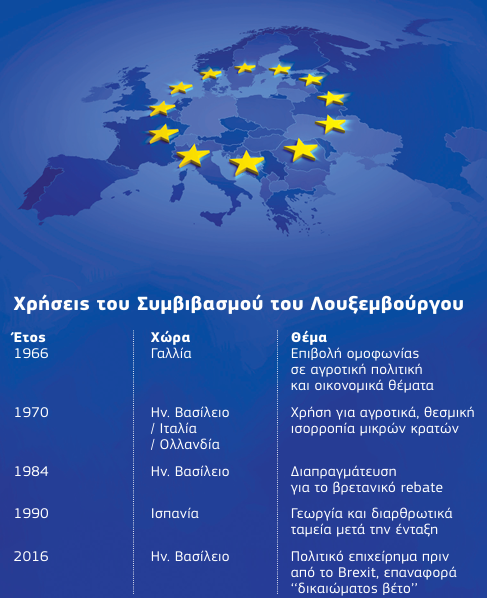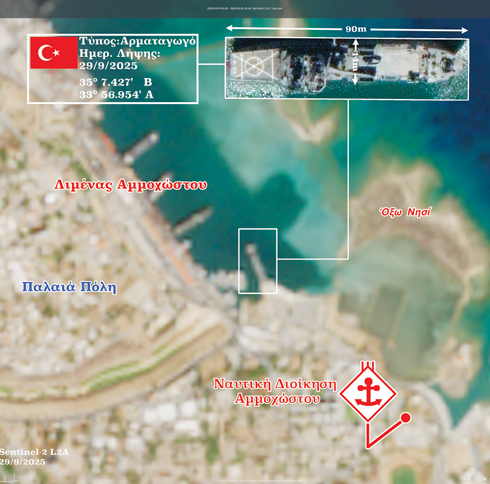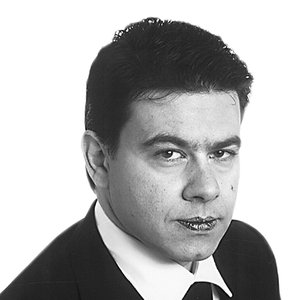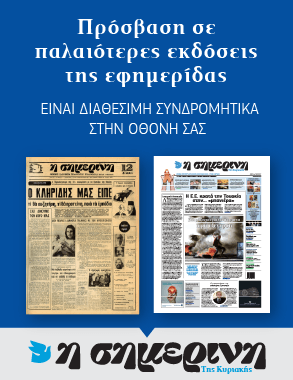Heavy Weapons Unloaded by Turkey
Why Cyprus–Greece Are Currently Left Out of the EU’s “Drone Wall”
While the President Was Meeting Tatar • The Luxembourg Compromise and Its Link to “Safe”
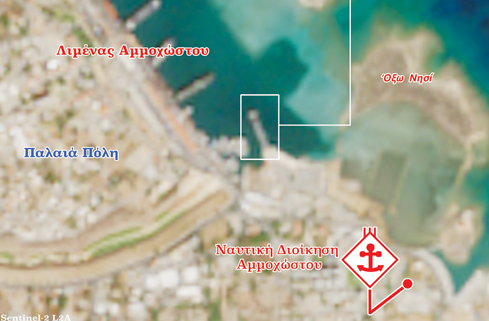
The Turks continue to unload heavy weaponry at the occupied port of Famagusta using the landing ship TCG Osman Gazi (NL-125), which has been stationed there since September 27, the very day the President of the Republic was meeting in New York with the Turkish Cypriot leader Ersin Tatar.
By last Friday, the Turkish vessel — which had sailed from Mersin — had already unloaded covered heavy armaments and reloaded other equipment, presumably to be serviced back in Turkey.
Continuous Upgrade of the Attila Forces
The ongoing modernization of Turkey’s occupying forces in Cyprus fully justifies the procurement of weapons systems by the Republic of Cyprus, which, under Article 51 of the UN Charter, operates within the framework of self-defense.
And yet, while the Turks were unloading weapons, Tatar was protesting to the UN Secretary-General that the Cypriot Government had acquired the Barak-MX air-defense missile system.
It is obvious that:
- • Turkey has no intention whatsoever of withdrawing its troops from Cyprus, given the continuous strengthening of its military infrastructure and the prevailing conditions in the Eastern Mediterranean, where Ankara seeks to play a leading role — with Cyprus serving as its “unsinkable aircraft carrier.”
- • Turkey regards Cyprus as: A) An integral element of its national security and of its consolidation as a regional power both inside and outside NATO. B) A key hub for controlling sea and air routes: from the Aegean to Iskenderun, from the Suez Canal to Gibraltar — hence its interest in Libya — as well as the corridor to and from the Black Sea via the Aegean.
Not coincidentally, Turkey is upgrading its military presence from the Dardanelles down to Iskenderun, including the port of Famagusta, which serves as Ankara’s long arm in the region. Turkish warships are almost permanently docked there, carrying out missions across the area.
The European “Drone Wall”
At the very same time that Turkey is unloading heavy military equipment on occupied EU territory, the informal European Council of October 1 decided — in response to the Russian threat — to establish by 2030 a so-called “Drone Wall” with a deterrent character.
This move was spurred by recent drone violations of Polish and Danish airspace, believed to be Russian in origin.
According to official EU documents, this decision is linked to other measures and policies, such as:
- • The “Safe” program, which foresees €150 billion for the defense industries of EU states as well as third countries, including Turkey, albeit under conditions (see Article 17 of the regulation).
- • The EU’s growing defense autonomy, which, however, is explicitly complementary to NATO — and cannot change without treaty revision and unanimous consent.
- • The Strategic Compass, adopted in 2022 after Russia’s invasion of Ukraine, covering diplomatic, environmental, humanitarian, and military security — extending as far as the Eastern Mediterranean.
Ξεφόρτωσαν βαρύ οπλισμό οι Τούρκοι
Turkey and the “Safe” Program
Here lies the contradiction:
These initiatives are designed primarily in response to Russia’s revisionist policy and occupation of Ukrainian land. But what about Turkey?
- • Turkey is also revisionist, an official EU candidate state and “strategic partner,” yet it occupies territory belonging to a member state — Cyprus — for 51 years.
- • Russia occupies Ukraine in violation of international law, threatening Europe through repeated airspace violations. But Turkey, too, daily violates international law and EU law by occupying Cyprus and threatening Greece.
So how can Ankara possibly participate in programs like “Safe,” designed to counter territorial occupations, while itself being an occupying power within the EU?
Would that not undermine the Union’s credibility and principles?
Without Cyprus…
The questions multiply:
- • Will the “Drone Wall” extend to cover Cyprus?
- • Why should it not, when Turkey not only occupies EU soil but also threatens Greece daily, including with drones?
Official EU statements so far identify only Russia as a threat. The frontline states prioritized for the Drone Wall are: Finland, Estonia, Latvia, Lithuania, Poland, Slovakia, Hungary, Romania, and Bulgaria, with Ukraine as a partner.
Commission President Ursula von der Leyen spoke of a drone wall strengthening the “Eastern Flank Watch” against Russia. EU High Representative for Foreign Affairs and Security Policy Kaja Kallas stressed it was already under discussion with eastern flank states and Ukraine.
But Greece and Cyprus have been pushed into “calm waters” — dialogue with Ankara and possible restart of Cyprus talks — effectively granting Turkey a free pass.
Options for Action and Article 4(2) of the Treaty
Since the matter concerns security, critical questions arise:
- • Should Turkey be allowed to co-develop weapons with EU partners under “Safe,” only to use them against Greece and maintain its occupation of Cyprus?
Policy options for Nicosia and Athens can be summarized as:
- • No Turkish participation in Safe or related EU programs as long as Ankara occupies Cyprus. Only a timetable for full troop withdrawal could make participation conceivable. Just as Athens demands removal of the casus belli in the Aegean, Nicosia must demand the complete withdrawal of Attila.
- • On the veto question: While the Safe regulation (based on Article 122 TFEU) seems to bypass veto powers, Article 17 leaves a window for Turkish participation. Yet there is the Luxembourg Compromise of 1966, an unwritten but accepted political practice allowing any state to block majority decisions if “vital interests” are at stake. Its force is even greater in matters of defense and security, especially when read in tandem with Article 4(2) TEU, which affirms national security as the exclusive responsibility of each member state.
- • Expansion of the Drone Wall southwards: It should quickly extend into the Eastern Mediterranean, covering EU vital interests against terrorism and external threats. This would align with the Strategic Compass, and while Turkey continues to threaten and occupy Cyprus, it cannot be part of such a scheme. Coordination in this region should rest with Cyprus and Greece in concert with other EU Mediterranean states.
The “Window of Opportunity”… or of Illusion?
If Turkey is unloading weapons in Famagusta, what “window of opportunity” for a Cyprus settlement is the President referring to?
Ankara is clearly entrenching the occupation, not preparing for troop withdrawal — a fundamental prerequisite for any viable solution.
Believing that a change of leadership in the north will unlock progress is illusory. Real movement will come only when:
- • The EU reframes the Cyprus issue as one of invasion and occupation.
- • Nicosia presses for deterrence measures, including weapons shipments to Cyprus — just as the EU did for Ukraine.
- • The Drone Wall is extended southwards as the bare minimum of European solidarity.
- • Above all, Turkey must not be allowed to participate in Safe.
The problem is not the lack of options, but the lack of political will and strategic vision.
